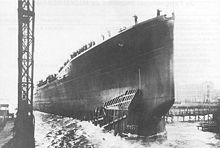Mackensen class
|
Side elevation of the Mackensen
|
||||||||||||||
|
||||||||||||||
|
||||||||||||||
|
||||||||||||||
|
||||||||||||||
The Mackensen- class was a class of battlecruisers of the German Imperial Navy that could no longer be completed due to the defeat in the First World War . They were the successors to the Derfflinger class ; the type ship was named after Field Marshal August von Mackensen . Originally seven ships were planned for the class. The last three were built as a replacement Yorck class according to different plans .
planning
The first three ships of the class were intended as replacements for two outdated protected cruisers of the Victoria Louise class , the Victoria Louise and the Freya, as well as the armored cruiser Blücher , which sank on the Dogger Bank . Only the fourth ship was supposed to be a multipurpose building , but was then intended to replace the armored cruiser Friedrich Carl , which sank on November 17, 1914 . Only the Mackensen was ordered in peacetime, the second ship was ordered from funds for the budget year 1915, the remaining five ships then as part of the 1916 war building program.
draft
The battlecruisers of the Mackensen class were further developments of the previous Derfflinger class, the characteristics of which had proven to be very favorable: the ships were strong and stable at high speed. The Mackensen class was supposed to take into account the latest developments in naval warfare technology, which above all meant an increase in caliber from the previous 30.5 cm guns to 35 cm guns. During the planning phase, the number of medium artillery guns in the 15 cm caliber was actually reduced from 14 to 12. Originally even the installation of 38 cm guns was planned, but due to feared size and weight problems as well as the doctrine of the Reichsmarineamte, which provided smaller guns on large cruisers than on battleships, this was initially refrained from. After details of the British battlecruisers of the Admiral class ( Hood ) and the laying of the keel of the Renown class became known, the last three ships, starting with the replacement Yorck, were revised again and should still be equipped with 38 cm guns.
Like their predecessors, the new ships were smooth-deckers without a forecastle or aft deck. In addition to the increase in caliber, they were also somewhat faster, but also displaced around 4,000 t more. For the first time, a bulbous bow was introduced. The Mackensen class sat-oil furnace coal to a mixed, however, a major change was the installation of so-called march turbines, which at cruise speed should reduce fuel consumption.
fate
None of the ships were completed. In the last years of the war, the priorities in shipbuilding had shifted in favor of lighter units (especially submarines), so that the construction of capital ships slowed down. When the war ended was Mackensen about 15 months away from completion, the replacement Freya , still on the slipway of Blohm & Voss, about 21 months Graf Spee (Boatyard Schichau works Gdansk) 12 months and spare Friedrich Carl at the Imperial Shipyard Wilhelmshaven even longer. According to the provisions of the Versailles Treaty , the ships were no longer allowed to be completed. For a short time in 1920 a conversion to tank motor ships with 18,500 tdw each was under discussion, but this was discarded due to inefficiency. Replacement Freya ran on March 13, 1920 makeshift from the pile to clear the slipway. The shipyard workers mockingly christened the ship after the incumbent Reichswehr Minister Noske - the name of Prince Eitel Friedrich was planned by the Reichsmarinamt - and then immediately scrapped. The other ships were also sold until 1922.
literature
- Breyer, Siegfried: Battleships and battle cruisers 1905–1970 . JF Lehmanns Verlag, Munich 1970, ISBN 3-88199-474-2 , p. 302-304 .
- Gröner, Erich / Dieter Jung / Martin Maass: The German warships 1815-1945 . tape 1 : Armored ships, ships of the line, battleships, aircraft carriers, cruisers, gunboats . Bernard & Graefe Verlag, Munich 1982, ISBN 3-7637-4800-8 , p. 85-87 .
- Strohbusch, Erwin: Warship building since 1848 . German Maritime Museum, Bremerhaven 1984, p. 40-41 .

